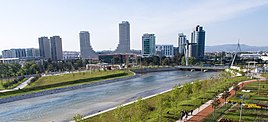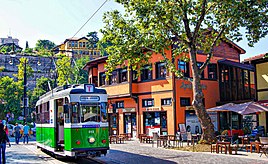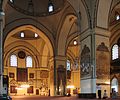world.wikisort.org - Turkey
Bursa (Ancient Greek: Προῦσα, Latin: Prusa, Ottoman Turkish: بورسه) is a city in northwestern Turkey and the administrative center of Bursa Province. The fourth-most populous city in Turkey and second-most populous in the Marmara Region, Bursa is one of the industrial centers of the country. Most of Turkey's automotive production takes place in Bursa.
This article may be expanded with text translated from the corresponding article in Turkish. (October 2020) Click [show] for important translation instructions.
|
Bursa | |
|---|---|
Metropolitan municipality | |
Clockwise from top: Hüdavendigar Park, Green Mosque, Irgandı Bridge and Orhan Gazi Square, nostalgic tram on Cumhuriyet Avenue, Koza Han, Bursa – Mt. Uludağ gondola lift | |
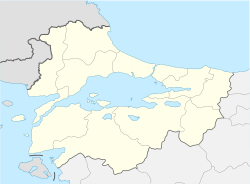 Bursa Location of Bursa within the Region of Marmara | |
| Coordinates: 40°11′N 29°03′E | |
| Country | Turkey |
| Region | Marmara |
| Province | Bursa |
| Government | |
| • Mayor | Alinur Aktaş (AKP) |
| Area | |
| • Metropolitan municipality | 10,422 km2 (4,024 sq mi) |
| • Urban | 1,290 km2 (500 sq mi) |
| • Metro | 17,806 km2 (6,875 sq mi) |
| Elevation | 100 m (300 ft) |
| Population (2021 estimation)[1] | |
| • Metropolitan municipality | 3,101,833 |
| • Density | 300/km2 (770/sq mi) |
| • Urban | 1,999,998 |
| • Urban density | 1,600/km2 (4,000/sq mi) |
| • Metro | 2,161,990 |
| • Metro density | 120/km2 (310/sq mi) |
| Time zone | UTC+3 (TRT) |
| Postal code | 16000 |
| Area code | (+90) 224 |
| Licence plate | 16 |
| Website | www.bursa.bel.tr |
UNESCO World Heritage Site | |
| Official name | Bursa and Cumalıkızık: the Birth of the Ottoman Empire |
| Type | Cultural |
| Criteria | i, ii, iv, vi |
| Designated | 2014 (38th session) |
| Reference no. | 1452 |
| Region | Europe |
As of 2019, the Metropolitan Province was home to 3,056,120 inhabitants, 2,161,990 of whom lived in the 3 city urban districts (Osmangazi, Yildirim and Nilufer) plus Gursu and Kestel, largely conurbated.[2]
Bursa was the first major and second overall capital of the Ottoman State between 1335 and 1363. The city was referred to as Hüdavendigar (خداوندگار, meaning "God's Gift" in Ottoman Turkish, a name of Persian origin) during the Ottoman period, while a more recent nickname is Yeşil Bursa ("Green Bursa") in reference to the parks and gardens located across its urban fabric, as well as to the vast and richly varied forests of the surrounding region. Mount Uludağ, the ancient Mysian Olympus, towers over it, and has a well-known ski resort. Bursa has rather orderly urban growth and borders a fertile plain. The mausoleums of the early Ottoman sultans are located in Bursa, and the city's main landmarks include numerous edifices built throughout the Ottoman period. Bursa also has thermal baths, old Ottoman mansions, palaces, and several museums.
The shadow play characters Karagöz and Hacivat are based on historic personalities who lived and died in Bursa in the 14th century.[3]
History

The earliest known human settlement near Bursa's current location was at Ilıpınar Höyüğü around 5200 BC.[4] It was followed by the ancient Greek city of Cius, which Philip V of Macedon granted to Prusias I, the King of Bithynia, in 202 BC. King Prusias rebuilt the city with the advice of general Hannibal of Carthage, who took refuge with Prusias after losing the war with the Roman Republic and renamed it Prusa (Ancient Greek: Προῦσα; sometimes rendered as Prussa). After 128 years of Bithynian rule, Nicomedes IV, the last King of Bithynia, bequeathed the entire kingdom to the Roman Empire in 74 BC. An early Roman Treasure was found in the vicinity of Bursa in the early 20th century. Composed of a woman's silver toilet articles, it is now in the British Museum.[5]
Under Byzantine rule, the town became a garrison city in 562 AD, where imperial guards were stationed there. Already by the mid-6th century, Bursa was known as a famous silk textile manufacturing centre.[6]
Bursa (from the Greek "Prusa") became the first major capital city of the early Ottoman Empire following its capture from the Byzantines in 1326. As a result, the city witnessed a considerable amount of urban growth such as the building of hospitals, caravanserais and madrasas throughout the 14th century, with the first official Ottoman mint established in the city.[6] After conquering Edirne (Adrianople) in East Thrace, the Ottomans turned it into the new capital city in 1363, but Bursa retained its spiritual and commercial importance in the Ottoman Empire.[7] The Ottoman sultan Bayezid I built the Bayezid Külliyesi (Bayezid I theological complex) in Bursa between 1390 and 1395[8] and the Ulu Cami (Grand Mosque) between 1396 and 1400.[9] After Bayezid was defeated in the Battle of Ankara by the forces Timur in 1402, the latter's grandson, Muhammad Sultan Mirza, had the city pillaged and burned.[10] Despite this, Bursa remained as the most important administrative and commercial centre in the empire until Mehmed II conquered Constantinople in 1453. The population of Bursa was 45,000 in 1487.
| Year | Pop. | ±% |
|---|---|---|
| 1487 | 45,000 | — |
| 1927 | 61,451 | +36.6% |
| 1955 | 128,875 | +109.7% |
| 1980 | 487,604 | +278.4% |
| 2000 | 1,184,144 | +142.8% |
| 2015 | 1,854,285 | +56.6% |
During the Ottoman period, Bursa continued to be the source of most royal silk products. Aside from the local silk production, the city imported raw silk from Iran, and occasionally from China, and was the main production centre for the kaftans, pillows, embroidery and other silk products for the Ottoman palaces until the 17th century.[12] Bursa was also notable for its numerous hammams (bath) built during the reign of Suleiman such as the Yeni Kaplıca.[6] As it was a significant cultural and trade hub, traders, most of whom were Armenians, became very wealthy.[13] However, this legacy of cultural pluralism in Bursa almost entirely ended due to the events that took place from 1895 to 1925, namely the Hamidian massacres, the Armenian genocide, and the population exchange.[14] The most influential study of Bursa's silk trade and economic history is the work of Ottomanist Halil İnalcık.[15]
Following the foundation of the Republic of Turkey in 1923, Bursa became one of the industrial centres of the country. The economic development of the city was followed by population growth and Bursa became the 4th most populous city in Turkey.

The city has traditionally been a pole of attraction, and was a major centre for refugees from various ethnic backgrounds who immigrated to Anatolia from the Balkans during the loss of the Ottoman territories in Europe between the late 19th and early 20th centuries. The most recent arrival of Balkan Turks took place between the 1940s and 1990s, when the People's Republic of Bulgaria expelled approximately 150,000 Bulgarian Turks to Turkey.[16] About one-third of these 150,000 Bulgarian Turkish refugees eventually settled in Bursa (especially in the Hürriyet neighborhood). With the construction of new industrial zones in the period between 1980 and 2000, many people from the eastern provinces of Turkey came and settled in Bursa.
Geography
Bursa stands on the northwestern slopes of Mount Uludağ (known as the Mysian Olympus in classical antiquity), on the banks of the Nilüfer River, in the southern Marmara Region. It is the capital city of Bursa Province, which borders the Sea of Marmara and Yalova to the north; Kocaeli and Sakarya to the northeast; Bilecik to the east; and Kütahya and Balıkesir to the south.
Climate
Bursa has a Mediterranean climate (Köppen climate classification: Csa) under the Köppen classification, and dry-hot summer subtropical climate (Csa) under the Trewartha classification. The city has hot, dry summers that last from June until September. Winters are cool and damp, also containing the most rainfall. There can be snow on the ground which will last for a week or two. Air pollution is a chronic problem in Bursa.[17]
| Climate data for Bursa (1991–2020, extremes 1928–2020) | |||||||||||||
|---|---|---|---|---|---|---|---|---|---|---|---|---|---|
| Month | Jan | Feb | Mar | Apr | May | Jun | Jul | Aug | Sep | Oct | Nov | Dec | Year |
| Record high °C (°F) | 25.2 (77.4) |
26.9 (80.4) |
32.5 (90.5) |
36.2 (97.2) |
37.0 (98.6) |
41.3 (106.3) |
43.8 (110.8) |
42.6 (108.7) |
40.3 (104.5) |
37.3 (99.1) |
31.0 (87.8) |
27.3 (81.1) |
43.8 (110.8) |
| Average high °C (°F) | 9.8 (49.6) |
11.4 (52.5) |
14.6 (58.3) |
19.2 (66.6) |
24.4 (75.9) |
28.9 (84.0) |
31.5 (88.7) |
31.7 (89.1) |
27.6 (81.7) |
22.2 (72.0) |
16.6 (61.9) |
11.5 (52.7) |
20.8 (69.4) |
| Daily mean °C (°F) | 5.4 (41.7) |
6.5 (43.7) |
9.0 (48.2) |
13.0 (55.4) |
18.1 (64.6) |
22.6 (72.7) |
25.1 (77.2) |
25.2 (77.4) |
20.8 (69.4) |
15.9 (60.6) |
10.7 (51.3) |
7.0 (44.6) |
14.9 (58.8) |
| Average low °C (°F) | 1.7 (35.1) |
2.4 (36.3) |
4.1 (39.4) |
7.4 (45.3) |
12.0 (53.6) |
16.2 (61.2) |
18.4 (65.1) |
18.7 (65.7) |
14.8 (58.6) |
10.8 (51.4) |
6.0 (42.8) |
3.3 (37.9) |
9.6 (49.3) |
| Record low °C (°F) | −20.5 (−4.9) |
−19.6 (−3.3) |
−10.5 (13.1) |
−4.2 (24.4) |
0.8 (33.4) |
4.0 (39.2) |
8.3 (46.9) |
7.6 (45.7) |
3.3 (37.9) |
−1.0 (30.2) |
−8.4 (16.9) |
−17.9 (−0.2) |
−20.5 (−4.9) |
| Average precipitation mm (inches) | 79.2 (3.12) |
78.2 (3.08) |
74.9 (2.95) |
68.6 (2.70) |
47.9 (1.89) |
42.8 (1.69) |
14.3 (0.56) |
17.5 (0.69) |
50.1 (1.97) |
84.4 (3.32) |
67.3 (2.65) |
93.9 (3.70) |
719.1 (28.31) |
| Average precipitation days | 14.87 | 13.60 | 13.40 | 11.43 | 9.63 | 7.30 | 3.33 | 3.60 | 6.77 | 10.67 | 10.93 | 14.53 | 119.8 |
| Average relative humidity (%) | 77 | 76 | 75 | 72 | 71 | 65 | 62 | 64 | 67 | 75 | 78 | 78 | 72 |
| Mean monthly sunshine hours | 83.7 | 90.4 | 124.0 | 165.0 | 217.0 | 264.0 | 300.7 | 275.9 | 217.0 | 145.7 | 111.0 | 77.5 | 2,071.9 |
| Mean daily sunshine hours | 2.7 | 3.2 | 4.0 | 5.5 | 7.0 | 8.8 | 9.7 | 8.9 | 7.0 | 4.7 | 3.7 | 2.5 | 5.6 |
| Source 1: Turkish State Meteorological Service[18] | |||||||||||||
| Source 2: Deutscher Wetterdienst (humidity 1973–1993)[19] | |||||||||||||
Economy

Bursa is the largest production centre of the Turkish automotive industry.[20] Factories of motor vehicle producers like Fiat, Renault and Karsan, as well as automotive parts producers like Bosch, Mako, Valeo, Johnson Controls, Delphi have been active in the city for decades. The textile and food industries are equally strong, with Coca-Cola, Pepsi Cola and other beverage brands, as well as fresh and canned food industries being present in the city's organized industrial zones.
Apart from its large automotive industry, Bursa also produces a substantial amount of dairy products (by Sütaş),[21] processed food (by Tat),[22] and beverages (by Uludağ).[23]

Traditionally, Bursa was famous for being the largest centre of silk trade in the Byzantine and later the Ottoman empires, during the period of the lucrative Silk Road. The city is still a major centre for textiles in Turkey and is home to the Bursa International Textiles and Trade Centre (Bursa Uluslararası Tekstil ve Ticaret Merkezi, or BUTTIM). Bursa was also known for its fertile soil and agricultural activities, which have decreased in the recent decades due to the heavy industrialization of the city.
Bursa is a major centre for tourism. One of the most popular skiing resorts of Turkey is located at Mount Uludağ, just next to the city proper. Bursa's thermal baths have been used for therapeutical purposes since Roman times. Apart from the baths that are operated by hotels, Uludağ University has a physical therapy centre which also makes use of thermal water.
Transportation
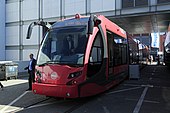
Bursa has a metro (Bursaray), trams[24] and bus system for inner-city public transport, while taxi cabs are also available. Bursa's Yenişehir Airport is 20 mi (32 km) away from the city centre. The citizens of Bursa also prefer Istanbul's airports such as Istanbul Airport and Sabiha Gökçen International Airport for flights to foreign countries, due to Istanbul's proximity to Bursa. There are numerous daily bus and ferry services between the two cities.

The 8.8 km (5.5 mi) long Bursa Uludağ Gondola (Turkish: Teleferik) connects Bursa with the ski resort areas 1,870 m (6,140 ft) high on the mountain Uludağ.[25]
The only railway station in Bursa is the Harmancık station on the Balıkesir-Kütahya railway, which was opened in 1930.
The average amount of time people spend commuting with public transit in Bursa, for example to and from work, on a weekday is 62 min. 12% of public transit riders ride for more than 2 hours every day. The average amount of time people wait at a stop or station for public transit is 18 min, while 31% of riders wait for over 20 minutes on average every day. The average distance people usually ride in a single trip with public transit is 8.1 km (5.0 mi), while 17% travel for over 12 km (7.5 mi) in a single direction.[26]
Education
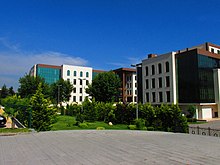
Bursa has two public universities and one private university. Uludağ University, founded in 1975 in Görükle, is the oldest institution of higher education in the city. Founded first as the Bursa University then renamed Uludağ University in 1982,[27] the university has a student body of 47,000, one of the largest in Turkey. Bursa Technical University[28] is the second public university of Bursa and was established in 2010, beginning education in the 2011–2012 academic year.
The first private university of Bursa was the Bursa Orhangazi University,[29] which started education in the 2012–2013 academic year. However, Orhangazi University was shut down by the Turkish government after the failed coup attempt of July 2016.
Istanbul Commerce University has opened graduate programs in Bursa in 2013.[30]
The Bursa Sports High School is located in Osmangazi district.[31]
Sports

The city has one professional football club, Bursaspor, which formerly competed in the Süper Lig (Super League), the top-tier of Turkish football, until finishing 16th at the end of the 2018–19 Süper Lig season and being relegated to the TFF First League. A few years earlier, Bursaspor had managed to become the Turkish champions at the end of the 2009–10 Süper Lig season, thereby becoming the second Anatolian club to ever win the Süper Lig championship title after Trabzonspor. Henceforth, Bursaspor was often considered to be one of the five biggest football clubs in Turkey, along with Galatasaray, Fenerbahçe, Beşiktaş and Trabzonspor. The club's relegation to the TFF First League at the end of the 2018–19 season was a major shock for its fans and became a first in the history of Turkish football: Never before a club which had won the Süper Lig championship title was relegated.
Bursaspor plays its home games at the Timsah Arena (meaning "Crocodile Arena", crocodile being the mascot of the team), which has a seating capacity of 45,000.
The city has a professional basketball team in the Turkish Basketball League, Tofaş S.K., which is among the most successful teams. The club plays its games at the Tofaş Nilüfer Sports Hall.
Politics
Bursa district Municipalities Local elections, 2019 | |
|---|---|
| AKP | 13 / 17
|
| CHP | 3 / 17
|
| MHP | 1 / 17
|
The current Mayor of the Bursa Metropolitan Municipality is Alinur Aktaş from the Justice and Development Party (AKP), in office since 2019, the AKP coalition won 49.6% of the vote against the CHP coalition which got 47% of the vote.[32]
Main sights
Ulu Cami (Grand Mosque)
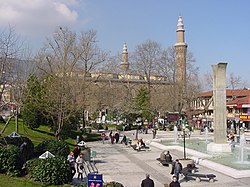
Ulu Cami is the largest mosque in Bursa and a landmark of early Ottoman architecture, which incorporated many elements from Seljuk architecture.
Ordered by Sultan Bayezid I, the mosque was designed and built by architect Ali Neccar in 1396–1400. It is a large and rectangular building, with a total of twenty domes that are arranged in four rows of five, and are supported by 12 columns. Supposedly the twenty domes were built instead of the twenty separate mosques which Sultan Bayezid I had promised for winning the Battle of Nicopolis in 1396. The mosque has two minarets.
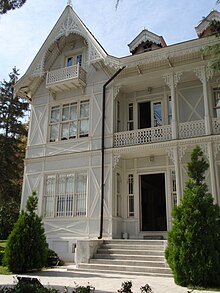
Inside the mosque there are 192 monumental wall inscriptions written by the famous calligraphers of that period. There is also a fountain (şadırvan) where worshipers can perform ritual ablutions before prayer; the dome over the şadırvan is capped by a skylight which creates a soft, serene light below; thus playing an important role in the illumination of the large building.

The horizontally spacious and dimly lit interior is designed to feel peaceful and contemplative. The subdivisions of space formed by multiple domes and pillars create a sense of privacy and even intimacy. This atmosphere contrasts with the later Ottoman mosques (see for example the works of Suleiman the Magnificent's chief architect Mimar Sinan.) The mosques that were built after the conquest of Constantinople (Istanbul) by the Ottoman Turks in 1453, and influenced by the design of the 6th century Byzantine basilica of Hagia Sophia, had increasingly elevated and large central domes, which create a vertical emphasis that is intended to be more overwhelming; in order to convey the divine power of Allah, the majesty of the Ottoman Sultan, and the governmental authority of the Ottoman State.
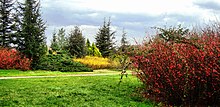

Places of interest
A brief list of places of interest in and around Bursa is presented below. For a longer list, see places of interest in Bursa.
Mosques and külliye complexes
- Bursa Grand Mosque and külliye
- Yeşil Mosque and külliye
- Bayezid I Mosque and külliye
- Muradiye Mosque and külliye
- Emir Sultan Mosque and külliye
- Orhan Gazi Mosque and külliye
- Hüdavendigar Mosque and külliye
- Koca Sinan Paşa Mosque and külliye
- İshak Paşa Mosque and külliye
- Karacabey Grand Mosque
- Karabaş-i Veli Cultural Centre
- Somuncu Baba Mosque
- Üftade Tekkesi Mosque and complex
- Babasultan Mosque and complex
Bazaars and caravanserais
- Yıldırım Bazaar (bedesten)
- Koza Han
- Pirinç Han
- İpek Han
Other historic monuments
- Bursa Castle
- Irgandı Bridge
- İnkaya Sycamore, very big and impressive 600-year-old tree (Platanus orientalis)
Museums
- Bursa Archaeological Museum
- Bursa Atatürk Museum,[33]
- Bursa City Museum,[34]
- Bursa Energy Museum
- Bursa Forestry Museum
- Bursa Karagöz Museum
- Bursa Museum of Turkish and Islamic Art
- Bursa Turkish Architecture Museum
- İznik Museum
- Mudanya Armistice House
- Museum of Ottoman House
- Tofaş Museum of Cars and Anatolian Carriages
Parks and gardens
- Uludağ National Park
- Bursa Zoo and Botanical Garden
- Bursa Hüdavendigar Kent Park
Hot springs and thermal baths
- Keramet hot spring
- Çekirge hot spring
- Armutlu hot spring
- Oylat hot spring
- Gemlik hot spring
- Çelik Palas thermal bath
Beaches
- Armutlu beach
- Kumla beach
- Kurşunlu beach
- Orhangazi beach
- Mudanya beach
Gallery
- Bursa Citadel Main Gate
- Orhan Gazi Mosque
- Emir Sultan Mosque
- Koza Han (Silk Bazaar) in Bursa
- Entrance of the Yeşil Cami (Green Mosque)
- Muradiye Mosque and Külliye in Bursa
- Governorate of Bursa
- Mt. Uludağ is a popular ski destination
- Statue of Atatürk in Bursa
- Şehreküstü Mosque
- Interior of Yeşil Mosque
- Bursa French Catholic Church
- Saltanatkapı (Citadel Main Gate)
- Old City Hall
- Tophane Clocktower
- Tomb of Osman Gazi
- Tomb of Orhan Gazi
- Interior of the Grand Mosque
- Koza Han (Silk Bazaar)
- Irgandı Bridge
- A view of Bursa in the late 19th century
- Bursa, circa 1895
- Atatürk delivering a speech in Bursa, 1924
- A view of Bursa from the foothills of Mt. Uludağ
Twin towns – sister cities
Bursa is twinned with:[35]
 Darmstadt, Germany (1971)
Darmstadt, Germany (1971) Sarajevo, Bosnia and Herzegovina (1972)
Sarajevo, Bosnia and Herzegovina (1972) Oulu, Finland (1978)
Oulu, Finland (1978) Kairouan, Tunisia (1987)
Kairouan, Tunisia (1987) Anshan, China (1991)
Anshan, China (1991) Bitola, North Macedonia (1996)
Bitola, North Macedonia (1996) Ceadîr-Lunga, Moldova (1997)
Ceadîr-Lunga, Moldova (1997) Kyzylorda, Kazakhstan (1997)
Kyzylorda, Kazakhstan (1997) Mascara, Algeria (1998)
Mascara, Algeria (1998) Kulmbach, Germany (1998)
Kulmbach, Germany (1998) Pleven, Bulgaria (1998)
Pleven, Bulgaria (1998) Plovdiv, Bulgaria (1998)
Plovdiv, Bulgaria (1998) Tirana, Albania (1998)
Tirana, Albania (1998) Košice, Slovakia (2000)
Košice, Slovakia (2000) Vinnytsia, Ukraine (2004)
Vinnytsia, Ukraine (2004) Pristina, Kosovo (2010)
Pristina, Kosovo (2010) Bakhchysarai, Ukraine (2010)
Bakhchysarai, Ukraine (2010) Momchilgrad, Bulgaria (2010)
Momchilgrad, Bulgaria (2010) Mogilev, Belarus (2013)
Mogilev, Belarus (2013) Hebron, Palestine (2014)
Hebron, Palestine (2014) Herzliya, Israel (2014)
Herzliya, Israel (2014) Veliko Tarnovo, Bulgaria (2017)
Veliko Tarnovo, Bulgaria (2017) Galkayo, Somalia (2018)
Galkayo, Somalia (2018)
See also
- 1855 Bursa earthquake
- Complex of Mehmed I
- Emirsultan Mosque
- Grand Mosque of Bursa
- Green Tomb and Mosque
- List of people from Bursa
- List of World Heritage Sites in Turkey
- Siege of Bursa
References
- "Bursa (Metropolitan Province, Turkey) - Population Statistics, Charts, Map and Location".
- "Bursa (Metropolitan Province, Turkey) - Population Statistics, Charts, Map and Location".
- "Karagöz'ün Tarihçesi".
- Roodenberg, J. J. (1995). The Ilıpınar Excavations I. the University of Michigan: Nederlands Historisch-Archaeologisch Institut in het Nabije Oosten te Istanbul. ISBN 9062580734.
- "British Museum - Collection search: You searched for Bursa, tomb". British Museum. Retrieved 25 May 2015.
- Dumper, Michael; Stanley, Bruce E. (2007). Cities of the Middle East and North Africa. ABC-CLIO. p. 101.
- "In 1363 the Ottoman capital moved from Bursa to Edirne, although Bursa retained its spiritual and economic importance." Ottoman Capital Bursa. Official website of Ministry of Culture and Tourism of the Republic of Turkey. Retrieved 19 December 2014.
- "Bayezid I Complex". ArchNet. Archived from the original on 2011-05-25. Retrieved 2009-06-28.
- "Great Mosque of Bursa". ArchNet. Archived from the original on 2011-09-19. Retrieved 2009-06-28.
- Mohammad Habib, Khaliq Ahmad Nizami, A Comprehensive History Of India Vol.-V: The Delhi Sultanat (1970), p. 128
- The city in the Islamic world, Volume 1, ed. Salma Khadra Jayyusi, Renata Holod, Attilio Petruccioli, André Raymond, page 362.
- Chen, Yuan Julian (2021-10-11). "Between the Islamic and Chinese Universal Empires: The Ottoman Empire, Ming Dynasty, and Global Age of Explorations". Journal of Early Modern History. 25 (5): 422–456. doi:10.1163/15700658-bja10030. ISSN 1385-3783. S2CID 244587800.
- "Armenian trade networks".
- "In the Eyes of a Turk: A History of Armenians from Bursa and Armenian-Turkish Relations".
- Lowry, Heath W. (2003). Ottoman Bursa in Travel Accounts. Indiana University. p. 1.
- Eminov, Ali, Turks and Other Muslim Minorities in Bulgaria, New York, Routledge, 1997, Höpken, W., "Modernisierung und Nationalismus: Sozialgeschichtliche Aspekte der bulgarischen Minderheitenpolitik gegenüber den Türken" in: SOE 7-8 (1986), Schönfeld, R., ed, Nationalitätenprobleme in Südosteuropa, Munich, Oldenbourg, 1997, p. 255-303, Erdinç, Didar, "Bulgaristan'daki Değişim Sürecinde Türk Azınlığın Ekonomik Durumu", Türkler, Ankara, 2002, s.394–400.
- Kara Rapor 2020: Hava Kirliliği ve Sağlık Etkileri [Black Report 2020: Air Pollution and Health Effects] (PDF) (Report) (in Turkish). Right to Clean Air Platform Turkey. August 2020. Archived (PDF) from the original on 2022-10-09.
- "Resmi İstatistikler: İllerimize Ait Mevism Normalleri (1991–2020)" (in Turkish). Turkish State Meteorological Service. Retrieved 24 April 2021.
- "Klimatafel von Bursa / Türkei" (PDF). Baseline climate means (1961–1990) from stations all over the world (in German). Deutscher Wetterdienst. Retrieved 12 January 2019.
- "Turkey: A centre of excellence in automotive industry". Automotive Meetings Turkey. Retrieved 3 October 2020.
- "Sütaş Süt Ürünleri A.Ş." Retrieved 25 May 2015.
- "Tat". Retrieved 25 May 2015.
- Uludağ Beverages
- DVV Media UK. "Bursa circular tramway opens". Railway Gazette. Retrieved 25 May 2015.
- "GD8 Bursa I + II + III - References - Company - LEITNER ropeways". www.leitner-ropeways.com. Archived from the original on 2016-10-12. Retrieved 2016-09-14.
- "Bursa Public Transportation Statistics". Global Public Transit Index by Moovit. Retrieved June 19, 2017.
 Material was copied from this source, which is available under a Creative Commons Attribution 4.0 International License.
Material was copied from this source, which is available under a Creative Commons Attribution 4.0 International License. - "Uludağ Üniversitesi Hakkında". Uludağ Üniversitesi Resmi Websitesi.
- "Bursa Teknik Üniversitesi". Btu.edu.tr. Retrieved 2013-03-26.
- "Bursa Orhangazi Üniversitesi". Bou.edu.tr. Archived from the original on 2013-03-18. Retrieved 2013-03-26.
- "Istanbul Commerce University at Bursa" (in Turkish). Archived from the original on 2012-08-27.
- "Bursa Celal Sönmez Spor Lisesi, geleceğin şampiyonlarını arıyor". Bursada Bugün (in Turkish). 14 June 2020. Retrieved 20 June 2021.
- "Bursa Seçim Sonuçları - 31 Mart Bursa Yerel Seçim Sonuçları". www.haberler.com (in Turkish). Retrieved 2021-08-15.
- "Bursa - Atatürk Museum".
- "Bursa City Museum".
- "Kardeş Şehirler". bursa.bel.tr (in Turkish). Bursa. Retrieved 2022-01-06.
Further reading
External links
На других языках
[de] Bursa
Bursa (von griechisch Προύσα .mw-parser-output .Latn{font-family:"Akzidenz Grotesk","Arial","Avant Garde Gothic","Calibri","Futura","Geneva","Gill Sans","Helvetica","Lucida Grande","Lucida Sans Unicode","Lucida Grande","Stone Sans","Tahoma","Trebuchet","Univers","Verdana"}Prousa), früher Prusa, ist mit 3,1 Millionen Einwohnern (Stand: 2021) die viertgrößte Stadt der Türkei und Hauptstadt der Provinz Bursa in der Westtürkei.- [en] Bursa
[ru] Бурса (город)
Бу́рса (тур. Bursa, или Пру́са греч. Προύσα) — крупный город на северо-западе Анатолии, четвёртый по величине в Турции после Стамбула, Анкары и Измира и административный центр одноимённого ила (области).Другой контент может иметь иную лицензию. Перед использованием материалов сайта WikiSort.org внимательно изучите правила лицензирования конкретных элементов наполнения сайта.
WikiSort.org - проект по пересортировке и дополнению контента Википедии
